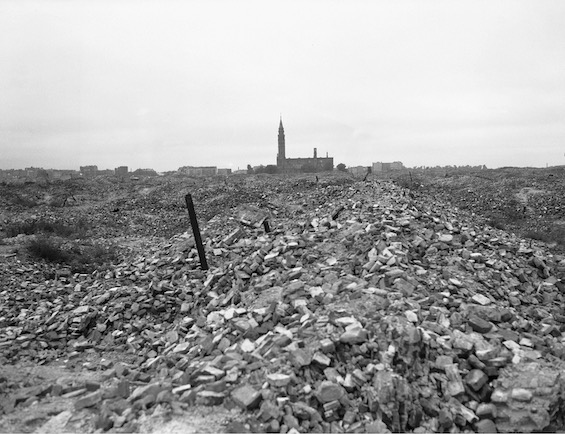
Estimated reading time: 5 minutes
Stories of the French Resistance crowd library shelves. They’re among the most popular books about World War II. But many give a misleading picture of reality. Only about 500,000 French men and women worked for the Resistance during the five years of the war, a little over one percent of the country’s population. And most enlisted only in the final months of the war, as Allied victory came to seem more likely. By contrast with resistance movements in other occupied countries, especially Poland and Yugoslavia, the French effort was paltry. In Poland, the Underground State was complex, highly organized, and numerous from the outset. It featured its own administration, judiciary system, and educational facilities as well as an army organized along traditional military lines. In Poland Alone, historian Jonathan Walker tells the story of the extraordinary Polish Resistance movement from the perspective of the British, its sole ally.
A strategic role in the Allied victory?
The Polish Home Army (the Armia Krajowa (AK) was a force of between 300,000 and 500,000 fighters organized along traditional military lines. It was affiliated with the Polish Government-in-Exile in London. There were several other fighting forces, including the Peasants’ Battalions (which merged with the AK by 1944) and the Communist Armia Ludowa (which fought on its own). All told, there were an estimated 650,000 combatants active in the resistance to the Nazis. Opposing them was a total of more than one million Nazis troops in 1944 who otherwise might have helped tip the balance for Germany either in France or in Belarus, when the last massive Soviet offensive began shortly after the Normandy Invasion. From that perspective, the Polish Resistance played a strategic role in helping ensure Allied victory in the war.
The Home Army assisted the Allies in gathering intelligence, too. Poland’s most important contributions were the German Enigma machine it supplied to the British and the detailed information about the Nazi V-2 program that led to the bombing of the rocket facility at Peenemünde. But also “48% of all reports received by the British secret services from continental Europe in between 1939 and 1945 came from Polish sources,” according to many scholars. “The total number of those reports is estimated at 80,000, and 85% of them were deemed high or better quality.”
Poland Alone: Britain, SOE and the Collapse of the Polish Resistance,1944 by Jonathan Walker (2008) 384 pages ★★★★☆

The apocalyptic impact of the war on Poland
Just as the heroics of the French Resistance distract American readers from the much more intense and longer-lasting resistance in Eastern Europe, the broader impact of the war in the West obscures its apocalyptic effects in the East. For example, of the six million who perished in the Holocaust, some 2.7 million were Polish. At war’s end, Warsaw was rubble. Its pre-war population of 1.3 million was 300,000 in 1945. And the country’s population as a whole shrank by more than two million despite a flood of refugees fleeing the Soviet Union at war’s end.
A British perspective on the Polish Resistance
Poland Alone is not a straightforward account of the extensive anti-Nazi movement in the country. It is, rather, an account of how sympathetic forces within Britain’s Special Operations Executive (SOE) struggled with its detractors in the Air Ministry and the Foreign Office to support the Home Army. Author Jonathan Walker devotes great detail—excruciating detail, if the truth be told—to the internecine political battles in London over the use of scarce wartime resources to support the Polish, especially the aircraft of Britain’s Bomber Command.
Walker repeatedly notes bitter complaints from the Poles about the lack of support from British airdrops to its forces on the ground. The complaints eventually rose all the way to Winston Churchill himself. But by the closing months of the war, the Prime Minister was far from supportive. After all, he had secretly flown to Moscow to carve up Eastern Europe with Joseph Stalin, dramatically shifting Poland’s post-war borders. And the resulting agreement doomed Poland to Communist rule for more than forty years.
About the author

British author Jonathan Walker is a member of the British Commission for Military History and Honorary Research Fellow in War Studies at the University of Birmingham. He became a full-time author after a successful business career. Walker has since written at least eight books of military history and contributed to several more. He was born in the UK in 1953.
For related reading
For information on other resistance movements in Occupied Europe, see 10 true-life accounts of anti-Nazi resistance. And for a comprehensive account of espionage, including the Resistance movements, see The Secret War: Spies, Ciphers, and Guerrillas, 1939-1945 by Max Hastings (A revisionist history of intelligence in World War II).
You might also enjoy:
- 10 top WWII books about espionage
- 10 top nonfiction books about World War II
- Good books about the Holocaust
- 7 common misconceptions about World War II
- The 10 most consequential events of World War II
And you can always find my most popular reviews, and the most recent ones, on the Home Page.


























